Amazing Anguilla BWI
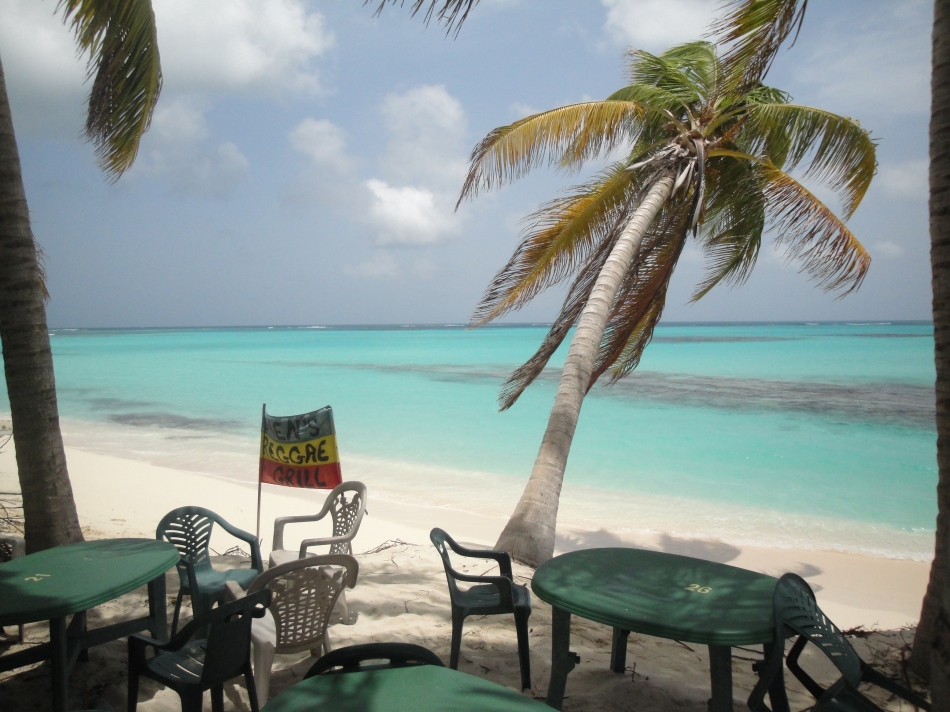
Shoal Bay West, Anguilla.
I almost missed Anguilla when planning for our 2010 Caribbean vacation. The scale of the online map of the Caribbean I first pulled up to peruse the Eastern Caribbean had reduced this petite island to a spot, barely noticeable next to the overly large text proclaiming the location of Anguilla’s “back yard” neighbor ST. MARTIN/SINT MAARTEN, nearby SAN JUAN and Antigua and Barbuda islands.
A recessionary budget and our desire to avoid overly-trammeled and expensive islands left St. Martin and Antigua off our list. Puerto Rico was similarly out of the question. I found myself looking at Barbuda as a possible destination- but pretty soon came away disappointed, because even at the height of the Big Recession, accommodation prices on Barbuda were just a bit pricey for our humble pocketbook.
Once I started exploring the possibilities that Anguilla offered, I was hopeful that I’d found an out-of-the-way, overlooked island destination that was scenic, safe, with friendly people, great snorkeling, clean and plentiful windward and leeward beaches, and decent grocery stores. Of course flight and accommodation costs needed to fall within our Reality Check realm.
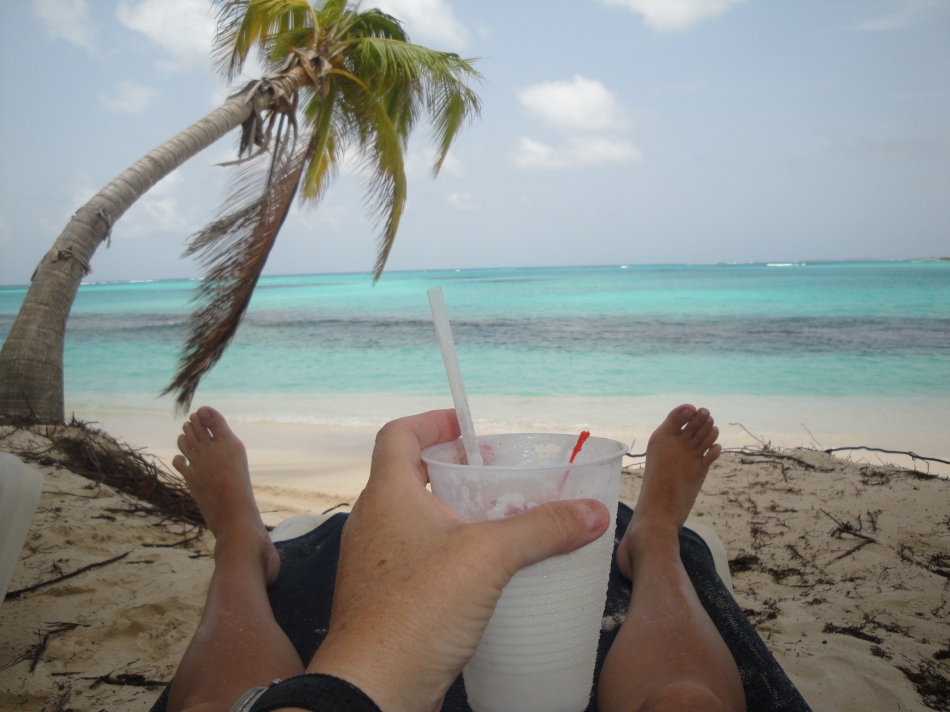
West Shoal Bay beach, Anguilla. I never drink mixed drinks except on a tropical vacay!
If at all possible, it would be terrific if the island was not too big (no cruise ship terminals but big enough to have at least 1 airport and to explore with a rental car) and not too small (pinched resources, limited infrastructure and too few Places to Go and Things to See), yet with a unique Caribbean character– a little “something” that would make it stand out in our memories. Too much to ask, right? Not for tiny, terrific Anguilla!
What’s so special about an island 16 miles long, 3 wide, with 13,000 human inhabitants, floating way out in the easternmost reaches of the Leeward Islands? Well, for starters, this is an island that sports a coat of arms with 3 orange dolphins against a simple white background, cavorting above a blue ribbon of representative Caribbean Sea.
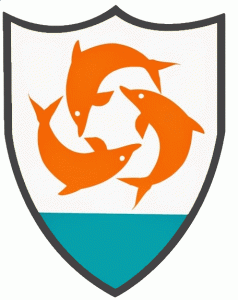
No fluff, no heavy-handed laurel wreaths, raging lions, menacing raptors, crossed swords, no curlicues and embellishments against busy, pretentious backgrounds. Just simple, clean design. I liked it. Looked good on a t-shirt, so I got one.
By the time we arrived at Ku’, our needs-a-bit-of-a-facelift resort accommodations situated on a wide stretch of white, firm, pristine windward Shoal Bay West beach, we were hot, hungry and just plain tuckered out from an 11 hour travel day. Our hegira took us from car to long-term parking near the Atlanta airport to a lengthy layover in a cramped, airless Ft. Lauderdale terminal to the airport on St. Martin, and thru interminable Customs and Immigration lines.

Shuttle boat from St. Martin to Anguilla. Swankiest water taxi I’ve ever been on!
We caught a van to drive us a few blocks to the ferry dock (still on St. Martin), where we eventually caught a shuttle boat to take us the 20 minute ride over to Anguilla—after a pause at the waterfront Police station so that our passports could be collected and scanned in to some massive database.
Arriving at the ferry landing in Blowing Hole on Anguilla, we found our rental car guy (arrangements having been made via email some weeks in advance), checked the “Little Car That Could” for dings, grabbed the keys, loaded in our carry-on bags, drove half the length of the island, took a wrong turn, found a grocery, and grabbed some goodies.
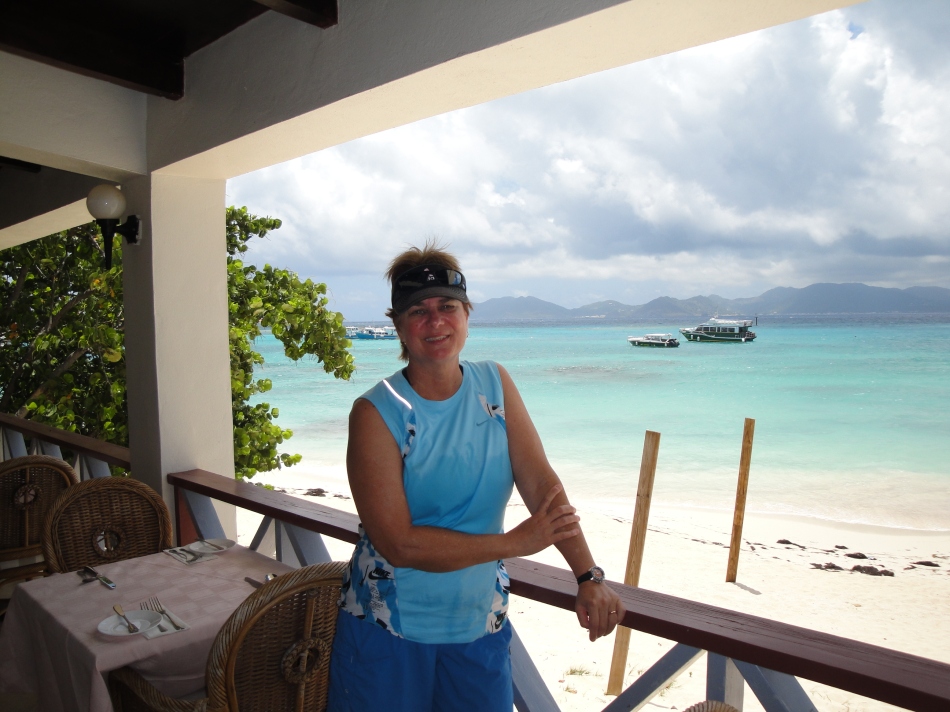
View of St. Martin from restaurant at Blowing Hole ferry area, Anguilla.
Somehow we made our way to Reception at Ku’- it was all a bit of a blur. Robin reported that I managed to keep enough presence of mind to drive on the left and dodge giant potholes, and the odd goat or ground dove that would suddenly materialize in front of us.
Dinner that evening was at a neighboring restaurant, Zara’s, where we had a delicious grouper meal. Unfortunately, the fish was a bit “off”, which put a real damper on our first full day. But of course we weren’t aware of the eventual effects of dinner when we later busied ourselves pulling the cushions off the couch in the living room of our smallish suite at Ku’ to add a measure of padding to the otherwise park bench-like “comfort” of our beds. But hey, we had central AC (!) fresh water in the full kitchen and the bathroom (even if the shower water pressure was barely a steady trickle), and a nice 2nd floor balcony with comfy chairs with a partial view of the beach.
Our room selection somewhat away from the beach was at the heart of how we got such a great deal on the accommodations for the week. A helpful Anguilla resident who frequented the Aguilla Guide Forum also produced a hand-drawn layout of the resort, which helped me choose a specific room number to request, to ensure we were at least on the top floor and on a corner position! You just gotta luv the Internet and especially local forums populated with helpful island residents and frequent visitors. Simply treasure troves of info.
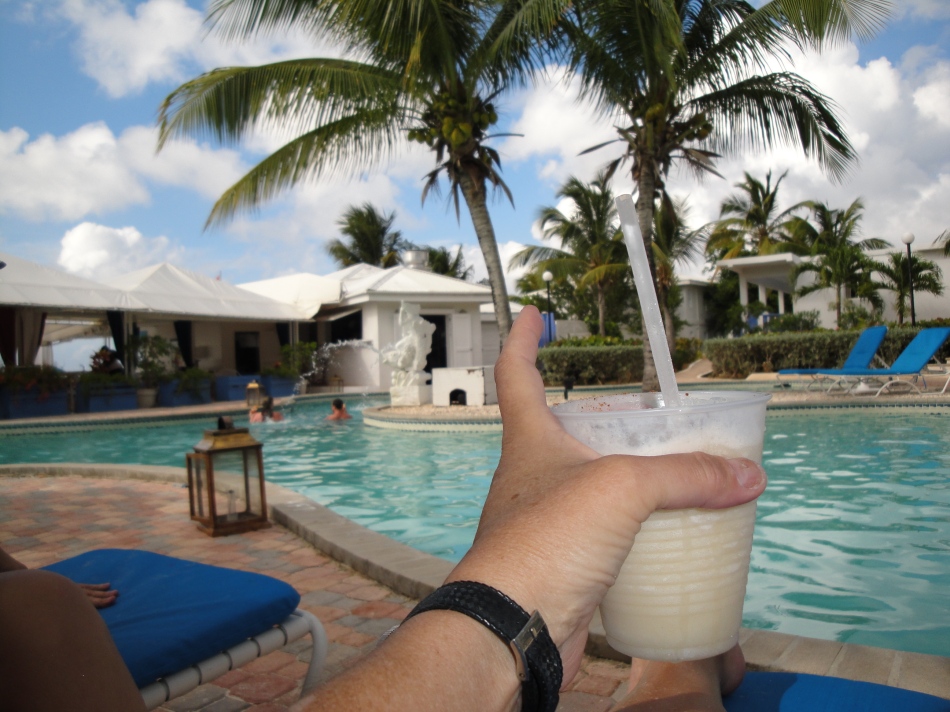
Ku resort poolside.
Rain, giant ocean rollers, windy conditions and our iffy tummys led us to spend most of the first day languishing around Ku’s lovely pool. We did drive into Sandy Ground, the main commercial center on the island to grocery shop and we also drove further down-island to find a couple of sandwich shops and beaches I’d read about on the forum. However, a mostly “down” day was a Best Bet, considering the iffy fish and still being worn out from the effort to get to our lovely corner of the British West Indies.
The following day (Monday) featured persistent heavy seas and high winds. We planned to snorkel offshore and were aware of several possible locations on the leeward side of the island. When I checked with the dive master at Ku’s dive shop, he kindly directed us to a place we weren’t familiar with–nearby Sandy Hill Bay where a lovely strip of reef, situated at the mouth of the bay, offered consistently good snorkeling in somewhat protected water.
We wandered around a bit on the narrow roads but eventually found the narrow, rocky, rough path that led off the paved road and down toward the water at Sandy Hill Bay. I gently coaxed Little Car That Could over the sharp pinnacles of ancient reef that constituted the track, trying to avoid puncturing the three matched tires and the fourth, under-sized tire that kept making a thunking sound as we slowly bumped along in 2nd gear. Once at the bottom of the track, I was thankful to be able to turn the car around in a small area of firm beach sand and point it back up the hill. Backing up that steep track may have proven to be a bit more excitement than I had bargained for.
Having the car so close meant we didn’t need to do our usual trekking down a lengthy beach to reach a convenient place to enter the water near a promising point of the iron-shore, where snorkeling is typically the best. In fact, the reef was less than 100 feet away from the car.
We stood on the beach gripping our snorkel gear to keep the wind from snatching it away and squinted at the sight of giant waves breaking on the outer part of the reef, which jutted off the beach and ran straight out into the bay for well over 400 feet. A good two or more feet of reef showed above the water, and as the waves slammed into the side of the reef facing the ocean, curtains of spume fanned up and out, creating a heavy mist that hung above the reef like a fog bank. Above the bay, low clouds scudded along, bringing relief from the mid-morning glare on the water while threatening certain rain.
We waded into the bay and donned our gear in shallow water. When I rolled over on my stomach and saw the sandy bay bottom slowly sinking away to deeper water, I sighed and grinned around my snorkel mouthpiece. It felt like coming home, being embraced in warm ocean waters, bobbing up and down on the waves, my body unconsciously orienting itself to the surge and slight onshore current. For someone raised on and near the ocean and the Gulf of Mexico in Florida, it’s hard to go a year or more in-between tropical snorkeling excursions. I guess missing such experiences ensures that I do my best to try to save up every memory I build.
On the way to the deeper section of the fringing reef we paused to float above two isolated coral “heads” (really chunks of the nearby reef) sitting on a bed of sand in about 20 feet of turbid water. We cruised around the heads, checking out the tropical fish and corals, then we headed over to the back side of the reef. We slowly made our way into deeper water, swimming against the moderate current as the waves pounded the opposite reef face less than 10 feet away. The force of the wave action coming across the top of the reef toward us was a bit scary, as was the sight of the thick cloud of bubbles and the booming sound created by every wave crash. We were careful to stay several feet away to avoid being pulled and then pushed into the coral wall.
As we finned along, the sand dropped away to 40 feet, and the reef started looking less beat-up. More live coral appeared, and the fish population grew in numbers and variety. Gazing down the length of the reef, I noticed that although the visibility was less than 70 feet, we could easily see the denizens of the reef nearby. I spotted three trumpet fish moving slowly along with the current, trying their best to look like benign floating objects rather than the opportunistic, rapid-attack predators they are. As I let myself drift closer, one of the three must have spotted me because it snuggled up close to a sea fan that was waving in the current and surge. I watched to see if the trumpet fish would shift colors to blend in a bit better with the sea fan’s color but the fish must have decided my level of threat wasn’t high enough to make it worthwhile to expend the energy to crank up the chromatophores.
Before long we started to get chilled. We’d been in the 80-degree water for 30 minutes or so, and it was time to turn around and catch the free ride down current, back to where we’d approached the main reef. We passed now-familiar landmarks, including a large pile of bleached out and broken coral that had tumbled down the reef face. There was the section where dozens of dinner plate sized spiny sea urchins had been uprooted from their anchor points, and were now lying upside down, scattered along the base of the reef like so many discarded toys. I knew that most would right themselves and eventually find a new home on the reef, but I thought that they might want to wait a day or so until the big seas dropped.
Passing back by the two isolated coral heads, I pointed out a squad of seven cuttlefish to Robin. We hovered just up current of the cuttlefish, watching to see what aquabatics they might perform. I recalled a larger “squadron” of cuttlefish we had watched while snorkeling off the island of Roatan in Honduras, as mentioned in my Roatan post.
Before us, this group appeared to be content to hang in the current between the two coral heads, all at the same depth, spaced apart like a squad of soldiers at inspection. They didn’t twirl or dance or change colors like the formation had off Roatan, but every once in awhile one did extend its tentacles and snatch some unseen tidbit from the water column. We floated, shivering; finally gave up and swam in, ready to sit in the sun to warm up.
The next morning we returned to the same reef, found two of the trumpet fish where we’d last seen them and waved hello to the cuttlefish, who were in the same spot, doing the same thing and thoroughly ignoring our attention.
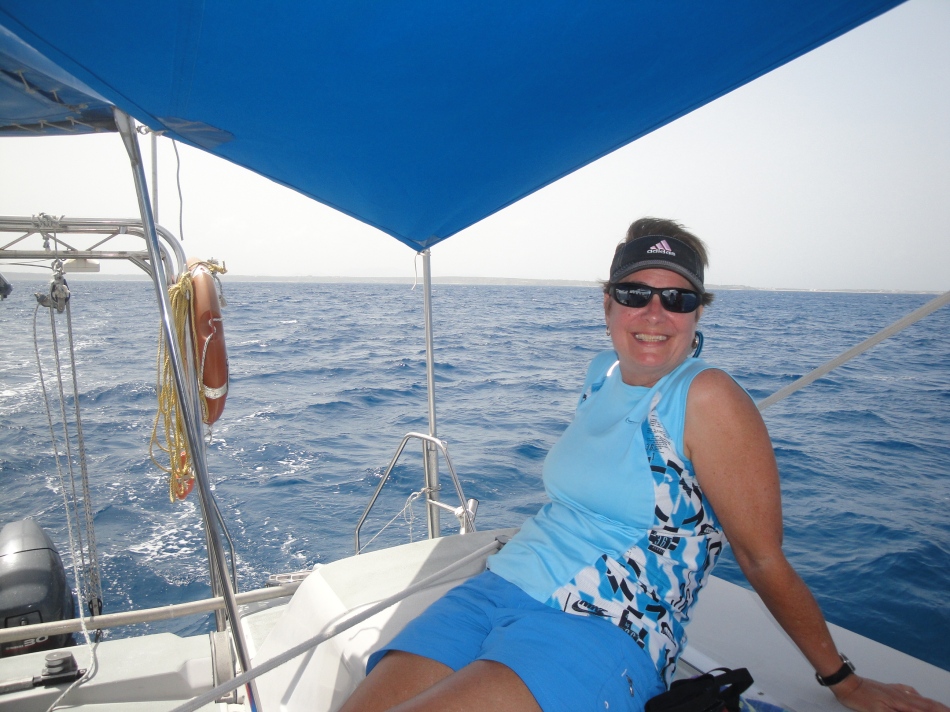
Lynn aboard Chocolat catamaran.
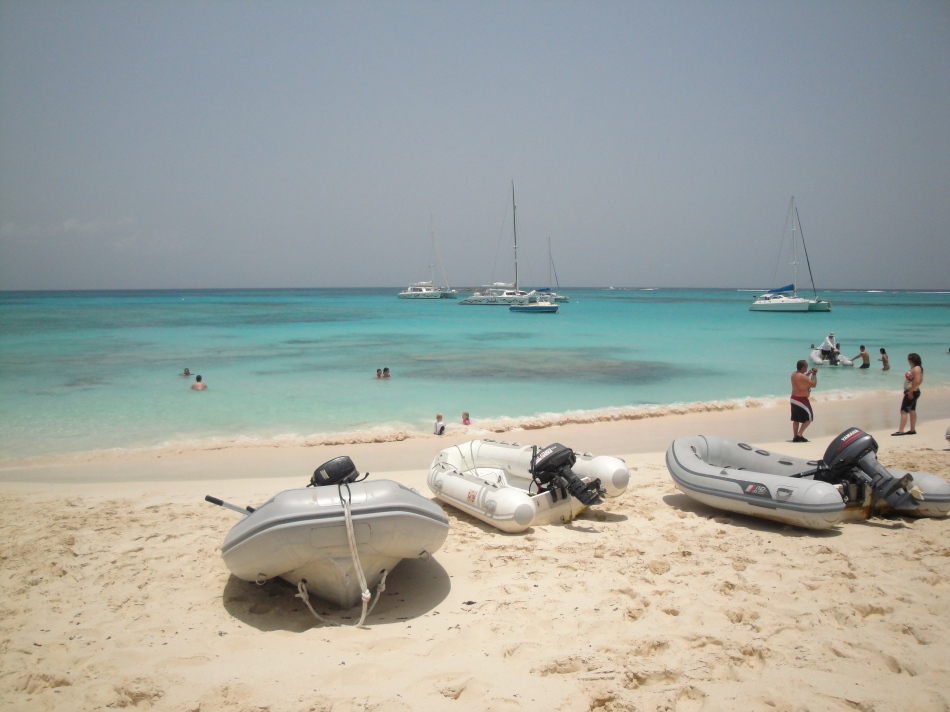
Prickly Pear cays, off Anguilla
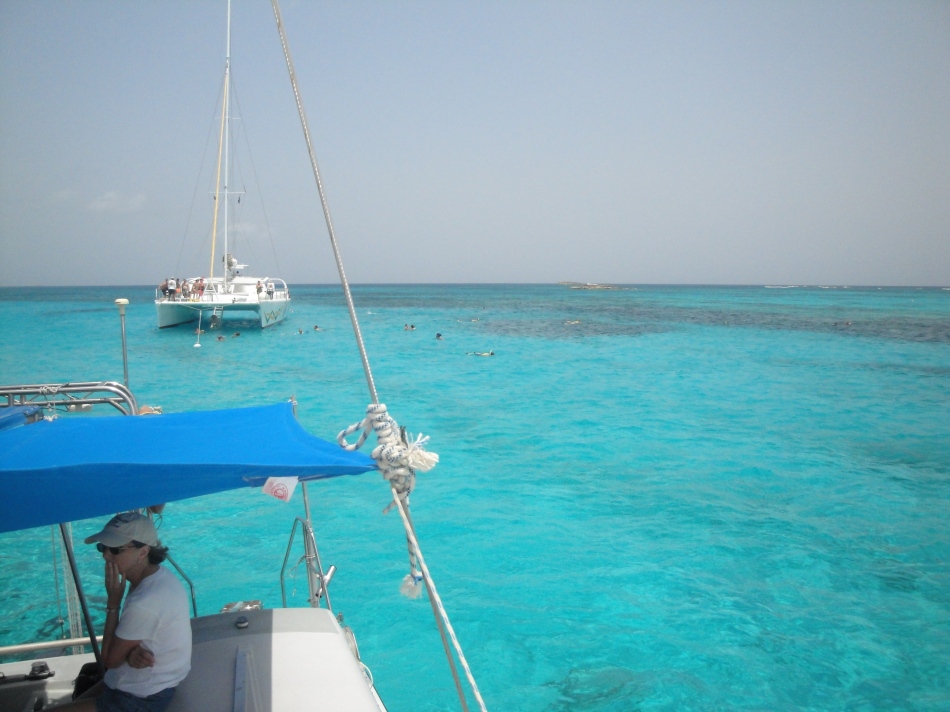
By Wednesday the seas had settled and the weather had turned from cloudy to sunny and hot. Early that morning we joined eight other vacationers aboard Chocolat, a 35-foot catamaran. We were headed six miles north of Anguilla to Prickly Pear cays for some snorkeling, chilling on the beach and lunch at the little bar and restaurant.
The ride over was breezy and pleasant, made all the more cheerful by lively conversation with our fellow passengers. We dropped anchor at Prickly Pear, joining four or five other large catamarans in the shallow, protected bay in front of the tiny beach Tiki bar tucked under the shade of sea grapes. The aquamarine color of the water beckoned, and as we dingied in to shore we counted 40 or more people snorkeling along the lengthy fringing reef.
Stepping out of the warm water and onto the beach was like standing in front of a giant oven door- the heat on this lee side was beyond stifling, with barely a breeze stirring. A handful of people wilted and sheltered under the few rental chairs and umbrellas perched on the broiling sand. We set our snorkel gear down on our chairs, stood in line at the Tiki bar for a drink and returned to our little patch of super-heated shade to sweat and gulp greedily at our now not-so-frozen drinks. Lunch was to be served in 45 minutes, so we quickly finished off our drinks, grabbed our snorkel gear and got in the water to cool off.
I swear I could hear my skin sizzle as I lowered my body gratefully into the cool water.
From shore it was a bit of a swim out to the reef, and the further we swam the stronger the current against us became. Pretty soon I was quartering the oncoming current, trying to discover a route to the deeper water where I suspected the current wouldn’t be as strong.
Turns out we were in Olympic Snorkeling mode, much as we had been last year off the island Anagada in the BVI. All the hard swimming really didn’t bring the reward of enjoying a pristine reef and lots of critters. Most of the reef was broken off and a lot was bleached and dead. Obviously big storms had wrecked damage. Fish were scattered and not very plentiful. We soon tired and headed in to shore.
I gave up on the patch of umbrella-heated shade and instead stood in the natural, and much cooler, shade of a large sea grape and chatted up fellow Chocolat passengers, a married couple who were from New England. Although they had bought a condo on Anguilla several years ago, they still seemed to be figuring out their home-away-from-home. The wife, in particular, was startled by the friendly and downright fearless behavior of the Banana Quits, tiny birds also called Sugar Birds, common throughout the eastern Caribbean. A quit flittered around my head, chirping and bugging me for a snack, then sat on a branch of the sea grape. I reached out slowly to see if I could entice it to alight on my hand when I spotted the quick darting movement of a small native Ameiva (lizard).
“Eck! A lizard!” the wife exclaimed in horror before I could point out the harmless little critter. As I herded the reptile with my hand around to the side of the branch where hubby could see it, the wife waxed about her abject fear of “all these lizards” found in the islands. I nodded in sympathy then grinned as I caught sight of a rather large green iguana that was shuffling along the hot white beach sand behind her, apparently headed for welcome shade—right under the picnic table bench where she held forth.
“Um, I’m glad you mentioned that you’re afraid of lizards”, I ventured, trying to figure out how to gently inform her about the approach of her nemesis. It was seconds away from contact. Before she could interject, I added “You may want to lift your feet up… ” and I pointed behind her. Hubby leaned down from his bench seat to see where I pointed. Looking surprised and not a little frightened, the wife nearly tumbled off her seat as she tried to lift her feet and spin around to look in the direction of the approaching danger.
I chuckled as the iguana scooted just past where the wife’s feet had been seconds ago and darted into the scrub. “That was a big one,” the husband said gravely, as he gave me a small wink.
Soon our group was invited to approach the restaurant and enjoy a hot (!) meal of BBQ chicken, plantains, and veggies under the partial shade on the wooden deck outside the building. The lack of breeze, the heat bouncing off the rough wooden decking and the sun beating on the shoulders of those unfortunate enough to arrive too late to secure the little shade made available under the tattered thatching overhead, and the heat radiating from our hearty, hot meal ensured that everyone ate rapidly, all too eager to return to the relative cool of the water or a piece of sea grape shade.
This wasn’t the first time I ran into the peculiar penchant of Caribbean hosts to “treat” visitors, especially those held captive on an organized trip, to a hot, steamy, heavy, meaty mid-day meal in a typically windless and shade-deprived setting! The few times I’ve been offered cool, refreshing fruit, light salads and ample cool water were on chartered sailboats during a day-sail excursion. Not a biggie but I wonder if the tendency is a cultural thing or an attempt to provide added value when a meal is included in the trip price.
Soon it was time to get back aboard Chocolat and make our breezy way back to Anguilla. The return trip was a bit more rough than the outgoing leg on our tired bodies. Once again, we day-trippers perched or leaned as best we could on the sides of the vessel in the shade of the main sail. While roomy, Chocolat’s design did not afford the comfort of a large cockpit ringed by seat cushions. The softest seating was in the (airless, hot) cabin or in the direct sun shining on the trampolines. Our group looked a bit like worn-out birds on a tree limb, crouching down into bits of shade, shifting position as the sun crept up already bright red feet, legs, and arms. After a hot day in the sun, a few drinks, a hearty meal and the constant bracing against the movement of the boat, everyone appeared tired, hot and ready to call it a day. Conversation was, understandably, minimal.
Our last two full days on the island were likely the best of our trip. Because the seas had settled, in the morning we were able to secure a lift in a small boat from Crocus Bay to nearby Little Bay (just up the shoreline) to enjoy what I had read in the Anguilla forum was the best snorkeling from shore. Calvin, the boat owner, was a taciturn but not unfriendly boat captain, who pointed out the best area to snorkel- as we passed it. And kept going. I thought he was challenging us when he said we “looked fit” enough to swim all the way back to the spot from Little Bay, where he would drop us off.
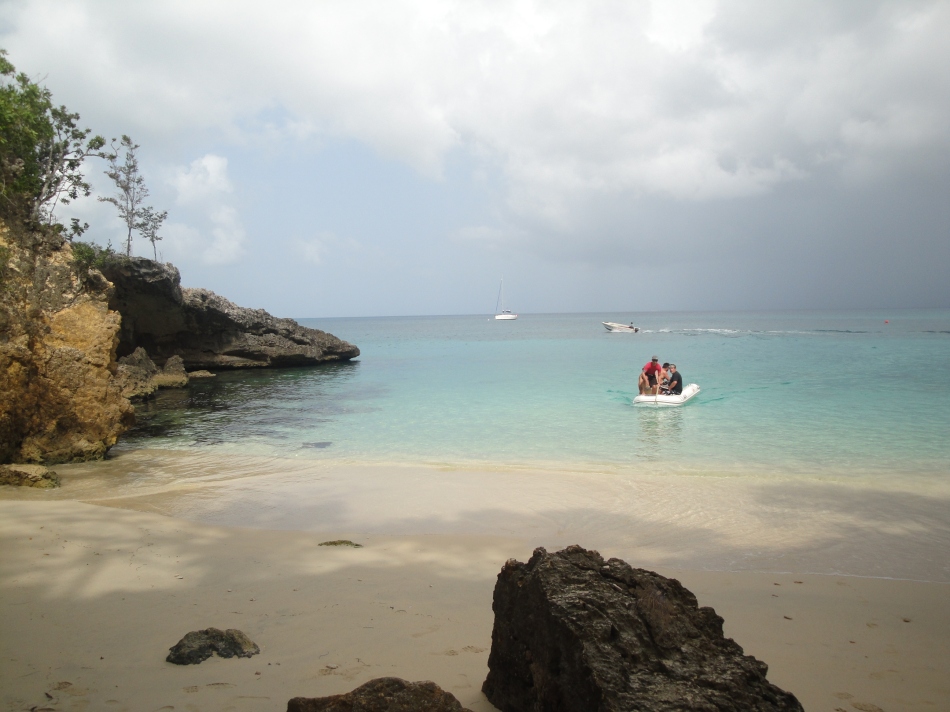
Little Bay, Anguilla, a hidden gem snorkel area.
We putted along, not 30 feet from the iron shore, which presented a 50-foot high steep, rough, barren, blackened and threatening façade. Over the eons the wave action had carved narrow canyons and valleys between what appeared to be finger-like extensions of ancient coral. We passed one small valley some 30 feet wide at the base, where a narrow, coarse shell-and sand mix of steeply sloping “beach” looked like it was loose enough to swallow a person up to their thighs. Little did I know then that the shallows mere feet from the sand would soon produce a delightful surprise.
A bit further along, we entered the mouth of Little Bay, which proved to be as scenic and secluded as we had expected. Calvin turned his boat around and held the stern off the sandy beach as we clambered over the transom with our snorkel gear, beach bags and cooler. He asked what time we wanted him to return, we said in 2 hours, and with a nod, he climbed aboard, cranked his outboard, and putted away, the sound of the boat engine dwindling as he rounded the corner and slowly made his way back toward Crocus Bay.
The engine sounds were soon replaced by the calls of gulls and terns swooping around the cliffs that towered overhead and the splashes of pelicans as they dove into the clear waters to catch a mid-day snack. The beach was as broad as the opening to the bay, some 300 feet, with waves gently lapping on hard-packed sand that gave way above the high tide line to boulders and large rocks lying half-buried in loose, fine sand that squeaked underfoot.
Tucking our gear in the shade afforded by the surrounding wall, we sipped drinks from the cooler and looked around, enjoying the scenery and the quiet.

Little Bay, Anguilla the hard way- down climbing sharp rocks! We preferred a quick boat ride.
Robin spotted a rope trailing down from high above, draped over the edge of the razor-sharp coral wall and dangling down to the sand some 40 feet below. “Must be the rope we were told about that the locals use to get down here,” she said. I walked over and, in my bare feet, gingerly stepped over the rock to grab the rope. I craned my neck to gaze up the incline, which was almost vertical, and shook my head, imagining the ruined vacation that would result from one small slip on that literal razor-edged “trail”. We decided it was well worth the $15.00 per person we had paid Calvin to deliver us safely to Little Bay!
The water was deliciously cool and clear as we finned our way around the southern point of Little Bay and slowly made our way back toward the “best snorkel spot”, the first of what turned out to be seven “fingers” that we would pass. The wall to our left sloped down to sand some 20 to 30 feet below us. The angle of the sun at mid-day lit up the bright sandy bottom apparently devoid of life. I studied the variety of small tropical fish and soft corals that decorated the wall, then turned my attention to the sandy bottom, noticing a rather large patch of the signature holes of garden eels, which I pointed out to Robin. The eels were, not unexpectedly, avoiding feeding in the light of the mid-day sun. If we were snorkeling earlier, or later in the day, we would likely have witnessed hundreds of them, their bodies extended from their holes, waving in the currents as they fed on passing tidbits.
As we crossed the mouth of each bay, the water got deeper where the currents had dug out a channel in the center. There, we saw a few small schools of fish and a couple of isolated coral heads topped by sea fans and decorated with the usual juvenile tropical fish found in the shallows. So far I wasn’t bowled over by the scenery, but the swim was effortless and the water, unusually warm for this latitude this time of year, was a comfortable temperature.
As we approached the southern point of the “best spot” snorkeling bay with the tiny beach, I noticed a large coral head near the base of the wall. Both the head and the wall were covered by soft corals and large sea fans, and many more tropical fish than I had seen yet snorkeling the waters in and around Anguilla. Things were looking up!
Suddenly, at the edge of the visibility curtain, between us and the wall appeared a large school of silversides, or “bait fish”. The closer we got to the fish, the more I began to realize that this was no mere school- it was a huge shoal of thousands of shiny fish, ranging from a few inches to just under a foot in length. And it was thick- so thick that I couldn’t see through the bodies to the wall just beyond. The shoal stretched from the water’s surface down more than 30 feet to the sand, and wound its way along the shoreline as far as I could see.
Robin floated nearby and we both looked on, entranced, as the fish darted, shifted and swirled as one mass. They seemed to generally be winding their way along the shore, hugging the wall and staying as closely packed as they could for protection. Pelicans dived into the densely-packed fish bodies from above as predators below waited for their chance to make a snack of any fish that fell away from the formation.
Knowing that predators would be lurking around such a large gathering of “bait” fish, I suggested to Robin that we avoid getting between the shoal and the wall, to reduce the chance of any part of our anatomy being mistaken for a yummy morsel. As we slowly swam next to the shoal, I looked down and out into the gloom to see if I could spot any predators. Ah, there was a small group of jacks with toothy grins, swimming parallel to the shoal in the opposite direction of the shoal’s general line of travel. And there was a barracuda- and another one, smaller. And, yep, there were the inevitable snappers, looking to snatch up any pieces that might be left by a larger predator.
Suddenly I spotted a tarpon. Then another. Then another. Before long I counted six, ranging from 3 feet to almost 5 feet in length. I pointed them out to Robin, who nodded, her brows raised inside her mask. Suddenly, at the edge of the visibility screen, a really large tarpon emerged. Longer than I am tall, and thicker around the middle than my thigh, it had a large scar around the right side of its mouth, clearly from damage done by a hook. I know because I got a good look at the damage as the silver torpedo came within 6 feet of where I floated, my body (and breath!) suspended.
Although I know the fish posed no threat to us, I was still startled and not a little discomfited by the sheer size of it. The last time I swam this close to anything that big was just last year, but that was a nurse shark headed away from us after being disturbed from a nap on the bottom of a bay. This fish wasn’t going anywhere except around and under the shoal of silversides, apparently completely ignoring our presence. I decided it was up to us to steer clear of any interference, so we allowed ourselves to drift past the busy point of land and into the shallows of the small bay nearby.
Here the water quickly went from over 30 feet in depth to less than 2 feet close to the beach. Peering through the constantly shifting wave of silversides curving around the inside of the bay, I was delighted to discover a thriving reef, chock-full of soft and hard corals of every color, and small and large sea fans, each with its attendant snail, waving briskly in the current. Purple, green, red and orange sea anemones trembled in the wave action from the surface and the currents below. The sun glinted brightly off the sand in the channels between coral heads and lit the top of the reef like a stage light.
Entranced, I tried to drink in the visual overload all at once, while carefully avoiding being shoved into the sharp coral by wave action. I moved my flippers just enough to keep them near the water’s surface and to maintain steerage way as I floated in the shallow water covering this amazing underwater oasis, my belly within inches of contact with razor-sharp coral, some of it tipped by fire coral.
Suddenly I spotted a young Hawksbill turtle floating in the small grotto carved between coral heads. My approach startled the youngster and as it darted away I saw its companion, who was floating in another canyon a bit farther on, take off. Both turtles sported a bright red metal tag on the leading edge of each flipper. I figured they were both about 3 years old, based on what we’d learned during our visit to the turtle sanctuary on the island of Bequia three years ago. There, we spent a morning learning everything you wanted to know about turtles, and especially Hawksbill turtles, and we became pretty adept at estimating this species’ age based on its size. Jacques Cousteau would be proud of us!
We’d been in the water for over an hour and were getting chilled, but it was still hard to say goodbye (for now) to this amazing little corner of the shoreline and head back down the coast to Little Bay. But leave we did, passing the now-familiar pack of predators lurking around the seemingly never ending flow of silversides.
We were so captivated by our experience that we told Calvin we’d like to do it again the next day. He asked skeptically if we’d made it all the way back to the snorkel spot he’d pointed out to us. When we said we did, and went on to describe what we’d seen, he actually seemed to warm to us a bit. Guess we might LOOK like two middle-aged-pampered-white-American-tourist-gals but hey, don’t judge a book by its cover!
That afternoon we found our way back to Gwen’s Reggae Bar, our favorite place to chill on the beach, which was conveniently a couple of miles away from Ku’.

Tap cooks chicken, Gwen’s Reggae Bar, Anguilla.
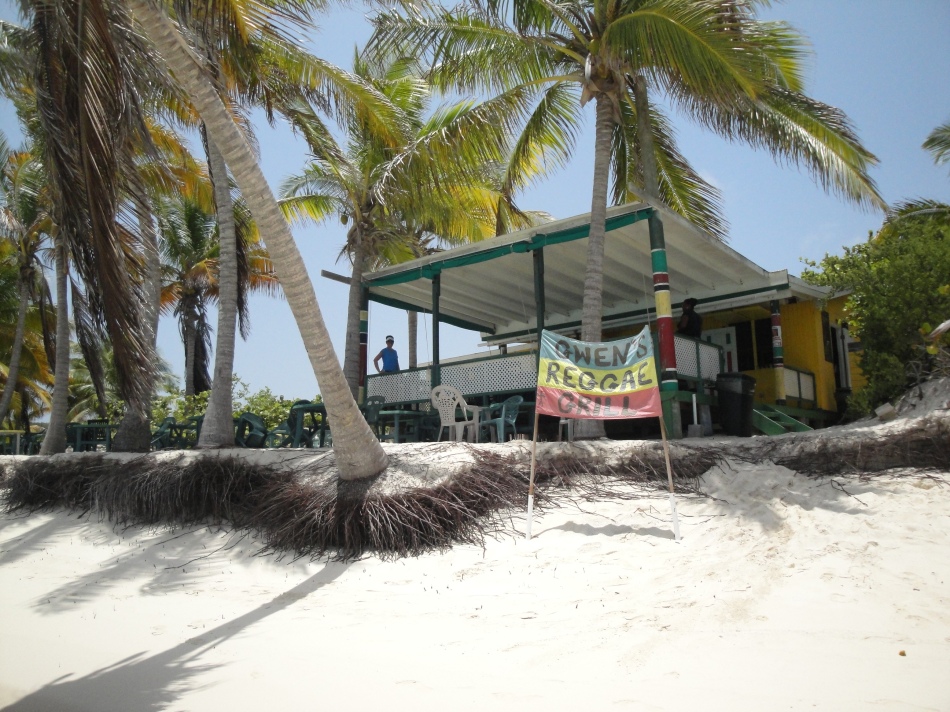
Gwen’s Reggae Bar, Anguilla
Tap, the cook, had the yummy BBQ chicken and ribs on the grill as we climbed the two wooden steps from the sand to the welcome shade of the open “beach shack” restaurant and bar. After a couple of frozen Pina Coladas and a delicious BBQ chicken and pasta salad lunch, we walked in the soft sand to the large and shady coconut grove situated next to Gwen’s. There we wiled away the afternoon in lounge chairs or a hammock strung between two tree trunks. We chatted and read books and dozed, the beach virtually to ourselves except for a few people strolling by on the beach below or the pelicans diving into the shallows. As beautiful as the water was, we didn’t swim because the breeze was brisk enough that we didn’t need to cool off. What a perfect place to hang- absolute bliss, and one of the most relaxing places I’ve found on any beach in my years of Caribbean travel.
Our last full day, Friday, mirrored the previous day. Little Bay was hosting two other couples when we arrived, but we didn’t stay to visit as we were anxious to get back to that magic little snorkel spot. Along the way there, I picked up a tiny, bright yellow Damsel fish-like attendant. It swam furiously right next to my jaw, apparently attracted by the bright yellow shirt I was wearing to protect my back and shoulders from the sun. When I would stop swimming and just float, it would dart in front of my face as if to say “Come on, let’s go!” I felt somewhat like a shark with its remora. Robin shook her head, giggling at the antics of my little pal.
As we arrived at the point of the pretty little bay, I was surprised to discover that the shoal was still there, accompanied by the same predators, including the tarpon gang featuring Big Daddy (or Momma). Amazing! We spent more time swimming around the bay, studying the reef and the critters and hanging just off the shimmering shoal of fish, watching the ballet created by the flashing patterns of the ever-shifting mass.
Later, sitting in Calvin’s boat as we put-putted our way back to Crocus Bay, I felt a twinge of sadness as I mentally waved goodbye to the fish beneath us. This being our last full day on the island, I knew that snorkeling for this trip was over. We would go on to enjoy a delightful lunch at the Ferryboat Inn near the (duh!) ferry landing, and spend our last quiet, breezy afternoon lazing about in the shade of the coconut palms next to Gwen’s. But as the evening came on and it was time to shower and pack our stuff for tomorrow’s lengthy travel day, we were both dragging around, not chatting much, the anticipation of the week’s vacation now replaced by lassitude and a touch of melancholy.
However. The excitement wasn’t quite over. We ended up spending over 2 hours in the nearby hospital emergency room because I managed to drive a large plug of earwax up into my Eustachian canal (while trying to REMOVE the annoying thing). After Robin went so far as to use two small straws from the bar to blow water jets into my (by now) painful ear to try to dislodge the plug, with no results, we realized it was either call the Doctor on call to Ku’ ($$$$$$) or go to the nearby hospital for proper lavage treatment.
The 1.5 hour wait seemed interminable. I was the only patient, so after I completed some initial paperwork, we sat in plastic chairs in the breezeway created by the wide open doors of the rustic hospital entryway, anticipating a short wait. The waiting area was peopled by two policemen, obviously there to provide security, who looked bored and hot, leaning against the makeshift registration counter. They were joined by a comatose male “receptionist”. The three were watching a soccer match blasting from a TV hung high in a corner of the waiting room. My plugged ear didn’t help reduce the cacophony of the noise, which soon ratcheted up beyond comprehension as a large family blew in with a cloud of dust from the parking lot. Grand kids, mom, dad, sisters, brothers, uncles and aunties of a very pregnant girl soon chased the policemen off and put the receptionist to work, shuffling papers, and irritated by the need to speak with all of the adult family members at once.
A woman sporting surgical scrub shoe covers bustled into the waiting area from behind a set of swinging doors to our left, passed through the area without a glance at the mayhem, and disappeared behind a different set of swinging doors at the entry to the opposite hall. This happened several times. Once she stopped for a second to get a paper cup of water from a standing water cooler under the blaring TV. Then she disappeared. It reminded me of a play in which various actors pop in and out of doors on the set, coming and going across the stage, maybe pausing to do a bit of business apropos of nothing, then scurrying away again.
Soon the woman-of-the-shoe-covers led the pregnant girl away through one of the sets of swinging doors. The noisy children went outside to play in the dust of the parking area. A couple of men settled in behind us to watch the soccer match. The women drifted outside to watch the children. We sat and waited.
Eventually I was seen by the doctor on call, a stern woman who was apparently disappointed that I wasn’t in need of her level of skills. Frowning, she motioned for me to sit in a chair and, wordlessly, she motioned to an assistant (nurse? hard to tell- no uniforms, no name badges), who was soon admonishing me, with humor, about causing my own problem. “Didn’t your mother tell you to never put anything in your ear?” she teased, in her soft island accent. In between squirting units of saline solution into my ear, my medical person told Robin “Next time you see her put something in her ear, you beat her!” While we laughed, I fleetingly noticed Robin wearing an appraising expression. Just for a minute.
Several units of saline solution and $58.00 later, my throbbing ear unplugged, I was happy to be driving the few miles back to Ku’ and grateful that the hospital was as close and as well stocked and staffed as it was! I could think of several islands I’ve stayed where the outcome would have been neither as quick nor as relatively painless.
The next morning we said goodbye to the friendly staffers at Ku’. Like everyone we had met on the island, they asked us if we had enjoyed our stay and to come back. We knew we’d heartily recommend Anguilla and the people who live there to anyone who desires a delightful, refreshing, relaxing, scenic, friendly, out-of-the way vacation spot.
We departed Anguilla with a sense of faint foreboding for its fate. Like other places we’ve discovered, we suspected our visit was barely in advance of the inevitable Tide of Progress crouching just over the horizon, waiting for the global economy to recover from the Great Recession before overwhelming these unique, but fragile, specs of land floating in a blue-green sea.

Poolside breakfast, Ku Resort, Anguilla.
Leave a comment